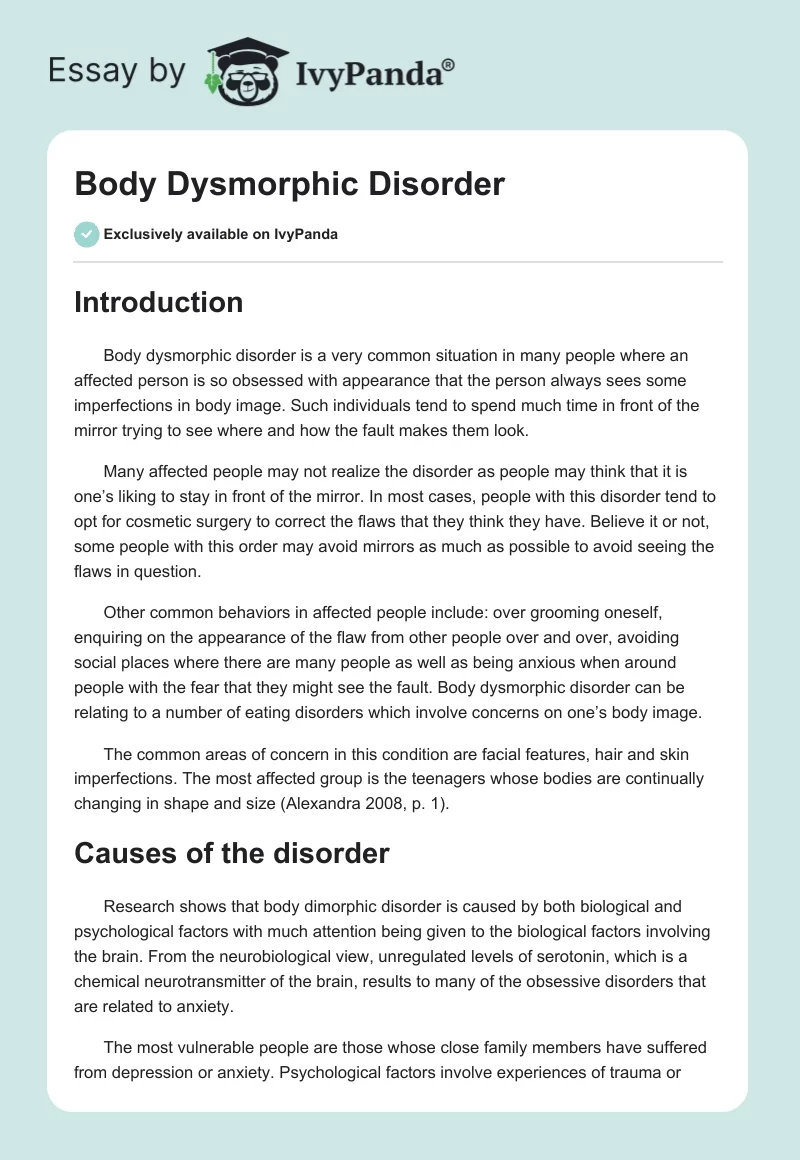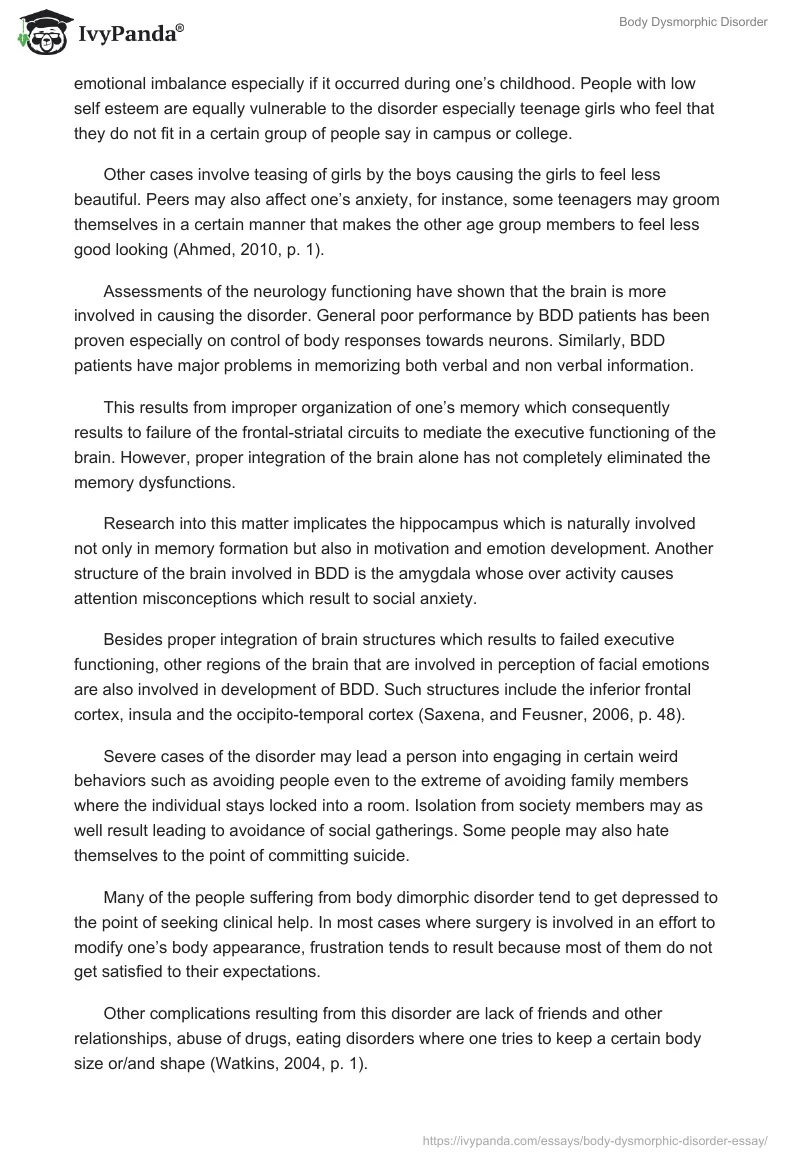Introduction
Body dysmorphic disorder is a very common situation in many people where an affected person is so obsessed with appearance that the person always sees some imperfections in body image. Such individuals tend to spend much time in front of the mirror trying to see where and how the fault makes them look.
Many affected people may not realize the disorder as people may think that it is one’s liking to stay in front of the mirror. In most cases, people with this disorder tend to opt for cosmetic surgery to correct the flaws that they think they have. Believe it or not, some people with this order may avoid mirrors as much as possible to avoid seeing the flaws in question.
Other common behaviors in affected people include: over grooming oneself, enquiring on the appearance of the flaw from other people over and over, avoiding social places where there are many people as well as being anxious when around people with the fear that they might see the fault. Body dysmorphic disorder can be relating to a number of eating disorders which involve concerns on one’s body image.
The common areas of concern in this condition are facial features, hair and skin imperfections. The most affected group is the teenagers whose bodies are continually changing in shape and size (Alexandra 2008, p. 1).
Causes of the disorder
Research shows that body dimorphic disorder is caused by both biological and psychological factors with much attention being given to the biological factors involving the brain. From the neurobiological view, unregulated levels of serotonin, which is a chemical neurotransmitter of the brain, results to many of the obsessive disorders that are related to anxiety.
The most vulnerable people are those whose close family members have suffered from depression or anxiety. Psychological factors involve experiences of trauma or emotional imbalance especially if it occurred during one’s childhood. People with low self esteem are equally vulnerable to the disorder especially teenage girls who feel that they do not fit in a certain group of people say in campus or college.
Other cases involve teasing of girls by the boys causing the girls to feel less beautiful. Peers may also affect one’s anxiety, for instance, some teenagers may groom themselves in a certain manner that makes the other age group members to feel less good looking (Ahmed, 2010, p. 1).
Assessments of the neurology functioning have shown that the brain is more involved in causing the disorder. General poor performance by BDD patients has been proven especially on control of body responses towards neurons. Similarly, BDD patients have major problems in memorizing both verbal and non verbal information.
This results from improper organization of one’s memory which consequently results to failure of the frontal-striatal circuits to mediate the executive functioning of the brain. However, proper integration of the brain alone has not completely eliminated the memory dysfunctions.
Research into this matter implicates the hippocampus which is naturally involved not only in memory formation but also in motivation and emotion development. Another structure of the brain involved in BDD is the amygdala whose over activity causes attention misconceptions which result to social anxiety.
Besides proper integration of brain structures which results to failed executive functioning, other regions of the brain that are involved in perception of facial emotions are also involved in development of BDD. Such structures include the inferior frontal cortex, insula and the occipito-temporal cortex (Saxena, and Feusner, 2006, p. 48).
Severe cases of the disorder may lead a person into engaging in certain weird behaviors such as avoiding people even to the extreme of avoiding family members where the individual stays locked into a room. Isolation from society members may as well result leading to avoidance of social gatherings. Some people may also hate themselves to the point of committing suicide.
Many of the people suffering from body dimorphic disorder tend to get depressed to the point of seeking clinical help. In most cases where surgery is involved in an effort to modify one’s body appearance, frustration tends to result because most of them do not get satisfied to their expectations.
Other complications resulting from this disorder are lack of friends and other relationships, abuse of drugs, eating disorders where one tries to keep a certain body size or/and shape (Watkins, 2004, p. 1).
Though the prevalence of the disorder is now low affecting only 2% of a population, researchers believe that it is now rising especially with the development of better diagnosis techniques as well as the increasing desire for people to look good especially now that modernization has been adopted in many countries.
Unlike eating disorders which are more prevalent in women, the body dysmorphic disorder equally affects both males and females although teenagers who suffer most are the girls compared to the boys counterparts (Veale, 2011, p. 1).
Impacts of the disorder
The most felt impact of the body dysmorphic disorder is psychological where the person affected gets depressed and may even suffer other depression related disorders especially eating disorders. When such individuals keep themselves locked in the household, they tend to engage in a lot of eating, mostly involving junk food, in order to avoid thinking about their faulty body parts.
These eating behaviors may eventually result to other health problems. Anxiety is another very common effect of the disorder which leads to certain behaviors such as panic or uneasiness.
A person suffering from body dysmorphic disorder is likely to suffer from emotional breakdown may be because of self-esteem which results to inferiority complex. When this happens, such people always find themselves crying whenever they think of the situation. Some may even go to the point of blaming God for not making them perfect (Mayo Clinic staff 2010, p.1).
The social life of an individual is as well affected when one suffers from this disorder. For instance, many such people avoid social gatherings and are always afraid of meeting people. Some may even lack friends because they think that they do not fit in and therefore they cannot be accepted by a certain group of people or classmates.
Occupational functioning may equally be affected when a person suffering from the disorder is reluctant to go to work because the person does not want to be seen with the faulty appearance. Some people may even give fake excuses for not being able to go to work especially when there are visitors at the work place (MedicineNet 1996, p. 1).
Conclusion
Body dysmorphic disorder is a serious illness and should be dealt with immediately when identified to prevent the mentioned complications from occurring. If one suspects certain behaviors form a friend or a family member, it is advisable to inform them in order to seek psychological help as early as possible.
Reference List
Ahmed, I. (2010). Psychiatric Manifestations of Body Dysmorphic Disorder. Web.
Alexandra. (2008). Body Dysmorphic Disorder: When the Mirror Lies. Web.
Mayo Clinic staff. (2010). Body Dysmorphic Disorder. Web.
Medicine Net. (1996). Body Dysmorphic Disorder (BDD). (1996). Web.
Saxena, S. and Feusner, J. D. (2006). Toward a Neurobiology of Body Dysmorphic Disorder. MBL Communications, pp. 48.
Veale, D. (2011). Body Dysmorphic Disorder – FAQ. Web.
Watkins, C. K. (2004). Body Dysmorphic Disorder. Web.


